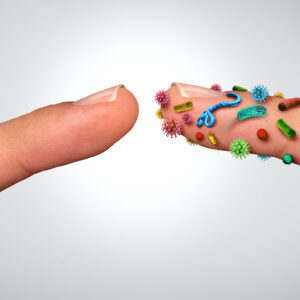Shingles is caused by the same virus that causes chickenpox, the varicella-zoster virus. After contracting chickenpox, the varicella-zoster virus remains latent in the tissue of your nervous system, where it is inactive. When the virus becomes active once again, it manifests as shingles. The most common symptom of shingles is painful blisters that can cover any part of the body. Most often, the blisters wrap around one or both sides of the torso, although they can happen anywhere. If you see a rash or blisters on your face, immediately contact your doctor, as shingles in this area can be much more dangerous, potentially causing brain swelling, eye problems, and other issues. Other shingles symptoms can include fever, chills, headache, and sensitive skin. While shingles is not life-threatening, it can be excruciating.
It can be helpful for shingles patients to understand the length of the infection and what they can expect as they manage shingles-related pain.
How long does shingles last? Generally, shingles can last between three to five weeks. A typical shingles infection follows a pattern.
First, you may experience a tingling sensation or even a burning pain from shingles that persists for between one and five days. Then, a red rash appears, usually in the same area. Following the rash, you may observe fluid-filled blisters covering the same location as the rash, which typically lasts about ten days. During this time, you are still contagious. You may transmit the virus to someone who is not immune to chickenpox, but it will manifest as chickenpox in that person, not shingles. During this time, you may want to avoid contact with people who have never had chickenpox, pregnant women, newborns, and people with weakened immune systems to avoid passing the virus to them. After the ten days have passed, the blisters usually begin to dry up and scab over, indicating that you are no longer contagious. Those scabs will clear up over roughly two weeks.
As shingles run their course, they tend to be extremely painful. The skin may be sensitive to the touch, and many shingles patients report burning sensations from the blisters and rash that can even cause sleeplessness, depression, anxiety, and weight loss. Sometimes shingles can develop into PHN, or post-herpetic neuralgia, where patients continue to experience shingles pain in the same area even after the scabs have cleared up. Older patients are at higher risk for developing PHN. Talk to your doctor if you experience these symptoms, as some medications can help manage the pain of PHN.
Shingles can also create other complications. The extreme itching of the blisters can lead patients to scratch, opening the blisters to infection. If the blisters become infected, they can be treated with antibiotics, but infection of the blisters can also prolong the shingles infection. Doctors recommend keeping the area clean and not scratching the blisters.
You can cope with shingles pain by using a cool washcloth on the affected skin, which can help soothe itching and irritation. You might also take a bath with colloidal oatmeal, which can soothe rashes, and use calamine lotion to see if it helps your skin. These approaches will not shorten a shingles infection, but they can help mitigate the pain shingles patients experience. As with any viral infection, be sure to rest, eat well-balanced meals, do light exercises that your doctor approves, stay hydrated, and avoid stress.
A high-quality first aid ointment can help provide homeopathic treatment to ease shingles pain and provide rapid and long-lasting relief. The best ointments penetrate the outer layers of the skin to directly treat shingles, eliminate bacteria and fungi that can cause infection, alleviate pain and itching, and promote quicker skin repair. It can even help stimulate blood flow to the applied area, which allows the body to heal itself naturally and helps prevent further flare-ups.




